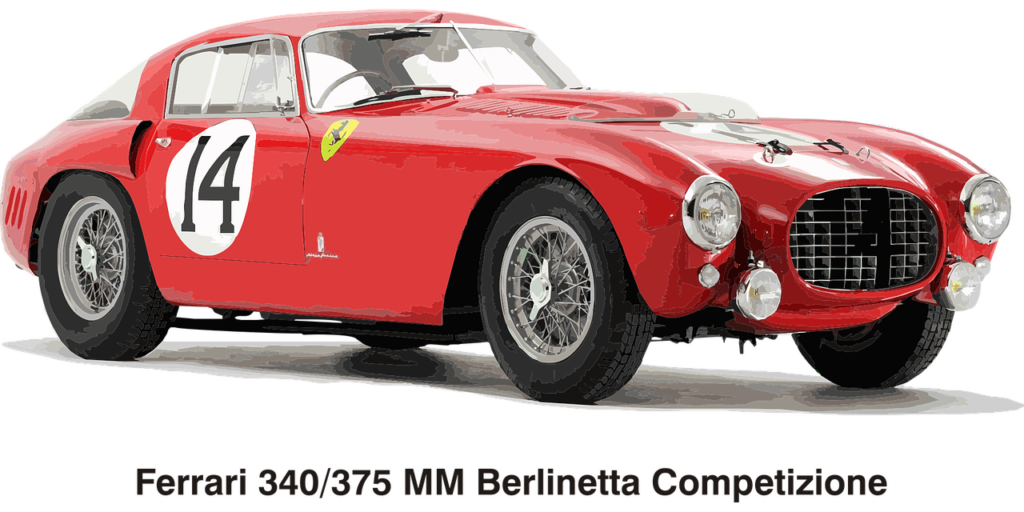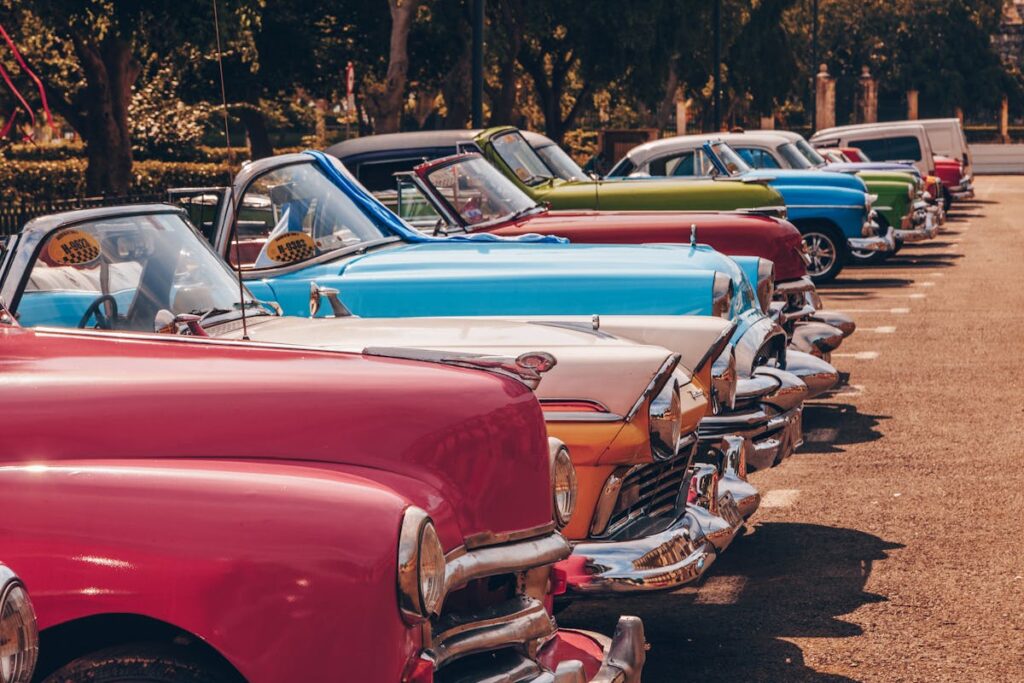In the domain of classic automobiles, there exists a unique subset of vehicles that are not only rare but also historically significant. These vehicles, including the Bugatti Type 57SC and Ferrari 250 GTO, embody distinctive eras of design and engineering. Their aesthetic appeal combined with their performance capabilities, place them in a league of their own. With limited production numbers and rich histories, these classic cars have become highly coveted pieces of art within the collector’s world. One might wonder, what makes these vintage vehicles so sought after and how have they shaped the evolution of the automotive industry?
Key Takeaways
- The Bugatti Type 57SC, with its supercharged engine and Art Deco aesthetics, is a symbol of automotive ingenuity.
- The 1931 Duesenberg Model J, a custom-built luxury car, embodies the resilience and innovative spirit of the American automobile industry.
- German engineering shines in the 1954 Mercedes-Benz W196, the first car to use direct fuel injection, known for its Grand Prix victories.
- The 1964 Aston Martin DB5, known for its association with James Bond, reflects high engineering standards and is an iconic luxury sports car.
- The 1962 Ferrari 250 GTO, a masterpiece of Italian craftsmanship, is highly sought after and revered for its performance and aesthetic appeal.
The Astonishing Bugatti Type 57SC
A masterpiece of automotive design, the Astonishing Bugatti Type 57SC, stands as a tribute to the golden age of classic cars. This iconic vehicle represents the pinnacle of Bugatti heritage – a reflection of the prowess and vision of Ettore Bugatti, the brand’s legendary founder.
The Bugatti Type 57SC, with its supercharged engine and exquisite design, is a symbol of automotive excellence. Its chassis, a groundbreaking innovation in the 1930s, combined lightness and rigidity, enhancing the Type 57SC performance to unprecedented levels. This car, capable of reaching speeds up to 120 mph, was a marvel in its era and remains so today.
Its low, sleek profile and elegant, flowing lines embody the Art Deco movement of the time, making it not only a mechanical wonder but also a piece of rolling art. This classic car is more than just a vehicle; it is a testament to human ingenuity and the endless pursuit of perfection.
In today’s world, where vehicles are often seen as disposable commodities, the Bugatti Type 57SC reminds us of a time when cars were crafted with passion, precision, and a deep respect for the art of engineering. It is a shining beacon of the past, illuminating the path for future automotive innovation.
Unveiling the 1931 Duesenberg Model J
Revealed at the height of the Great Depression, the 1931 Duesenberg Model J stands as a stark contrast to the economic gloom of its era. With its luxury craftsmanship and advanced engineering, it became an icon of American opulence and sophistication, a symbol of the very zenith of the Duesenberg legacy.
The Model J’s extravagance was evident in every aspect of its design. Its straight-eight engine, known for its superior performance, was a triumph of automotive engineering. This power-packed beast boasted an impressive 265 horsepower, a remarkable feat for its time. The Model J was capable of achieving speeds of up to 119 mph, rivaling the performance of modern sports cars.
The Duesenberg Model J wasn’t just about power and performance, though. Much of its appeal lay in its exquisite detailing and luxury craftsmanship. Each vehicle was custom-built, with no two cars being identical. The bodywork was a masterpiece of design, reflecting the finest in automotive styling of the era.
In an era of economic despair, the 1931 Duesenberg Model J was a beacon of American resilience, a manifestation of the country’s spirit of innovation and luxury. The Model J wasn’t just a car, it was a piece of automotive history, a tangible remnant of the Duesenberg legacy.
The Coveted 1954 Mercedes-Benz W196
The 1954 Mercedes-Benz W196, a classic automotive masterpiece, is a tribute to the zenith of German engineering and design during the mid-20th century. Its unique design features, including streamlined bodywork and direct fuel injection, revolutionized the industry and set new standards for performance. Beyond its technical prowess, the W196’s historical significance, having dominated the Formula One circuit and being piloted by legendary racing driver Juan Manuel Fangio, adds to its profound allure and prestige among classic car enthusiasts.
W196’s Unique Design Features
No less than six distinctive design features set the 1954 Mercedes-Benz W196 apart from its contemporaries. In the domain of aerodynamic innovations, the W196 introduced a streamlined chassis, a design feature essential for high-speed stability. This was complemented by the innovative inboard brakes, reducing un-sprung weight, allowing the car to handle better at high speeds. The W196 was the first car to use a direct fuel injection system, an innovation which supplied the precise amount of fuel into the combustion chamber, enhancing performance and efficiency.
The interior craftsmanship of the W196 was no less impressive. A beautifully designed instrument panel provided the driver with crucial information in a clear, concise manner. Distinctive bucket seats, upholstered in high-quality leather, offered superior comfort, while the unique placement of the gear lever on the dashboard demonstrated Mercedes-Benz’s commitment to ergonomic design.
Lastly, the W196’s distinctive exhaust system, with its unusual side exit design, not only guaranteed peak engine performance, but also became a signature feature of the car. These combined elements made the 1954 Mercedes-Benz W196 an exemplar of automotive design, setting new benchmarks for performance, comfort and style.
Historical Significance of W196
Marking a significant milestone in automotive history, the 1954 Mercedes-Benz W196 not only revolutionized design but also redefined performance standards. This classic beauty is a representation of Mercedes-Benz’s engineering excellence, setting new boundaries in the automotive industry and leaving an indelible mark on its racing legacy.
The W196 is renowned for its innovative features, such as its streamlined body and direct fuel injection, which were groundbreaking at the time. These advancements not only set the W196 apart from its contemporaries but also paved the way for subsequent models. Its superior speed and handling elevated its status within the racing fraternity, helping to secure multiple Grand Prix victories.
The W196’s enduring influence can be seen in the design and performance of modern racing cars, demonstrating its continuing relevance. Its historical significance lies not just in its technological achievements, but in the way it transformed perceptions of what a racing car could be. The 1954 Mercedes-Benz W196 is not just a classic car; it’s an emblem of automotive evolution, a symbol of a time when the quest for speed and precision triggered a wave of innovation that still resonates today.
Exploring the 1964 Aston Martin DB5
Although many classic cars have made their mark in history, few have achieved the iconic status of the 1964 Aston Martin DB5. This masterpiece of automotive engineering is a shining example of the high standards that Aston Martin has consistently maintained in the luxury sports car segment.
The DB5 boasts an all-aluminum engine, a then-novelty that greatly enhanced performance. With an acceleration of 0-60 mph in just 7.1 seconds, it was a marvel in an era when most cars struggled to hit 60 mph. Aesthetically, the DB5 is a timeless beauty. Its sleek lines, coupled with a refined interior, embody the style and sophistication that have become synonymous with Aston Martin.
Its popularity was further cemented by its association with the James Bond franchise, which made it a cultural icon. The DB5’s various modifications, including an ejector seat and machine guns, solidified its place in pop culture.
Few cars manage to encapsulate the spirit of their era as the 1964 Aston Martin DB5 does, a reflection of the brand’s commitment to quality and innovation. Its enduring appeal is a reflection of the timeless allure of luxury sports cars.

The Impeccable 1962 Ferrari 250 GTO
Celebrated as a masterpiece of Italian craftsmanship, the 1962 Ferrari 250 GTO is a classic car that has carved out a prestigious niche in automotive history. Its seductive curves and aerodynamic design, paired with an engine that roars with power, is a demonstration of the golden age of motoring.
The 250 GTO was built not only for speed, but also with a focus on the driving experience, offering a blend of raw power and agility. This combination made it unrivaled on both the road and track. The V12 engine, innovatively designed by Gioacchino Colombo, offered a thrilling symphony of sound and an unparalleled performance, contributing to its legendary status.
The value of this car has escalated over the years due, in part, to the specific restoration techniques employed. Preserving its originality while enhancing its features has been a delicate balancing act. Restorers have meticulously maintained the car’s authentic character while incorporating modern functionality. The 1962 Ferrari 250 GTO stands as a demonstration of careful preservation and a passion for motoring excellence, embodying the spirit of its era while continuing to captivate the hearts of car enthusiasts all over the world.
Spotlight on the 1957 BMW 507
While the 1962 Ferrari 250 GTO exemplified Italian craftsmanship, another classic car from the same era, the 1957 BMW 507, represented the pinnacle of German engineering. The 507’s design legacy is truly one to be admired. It was the brainchild of Albrecht Graf von Goertz, a renowned industrial designer, who created a timeless, elegant roadster that still turns heads even today.
The BMW 507 bridged the gap between the sports car and luxury segments, offering a unique blend of performance and comfort. Under the hood, the 507 housed a 3.2-liter V8 engine which delivered a thrilling driving experience. The engine’s roar, combined with the car’s agile handling, made every drive an unforgettable journey.
At its time, the 507 was BMW’s bid to compete with Mercedes-Benz in the luxury car market. Though the car didn’t achieve commercial success, largely due to its high price, it became a design icon and a collector’s favorite. Today, 507’s are among the most sought-after classic cars, with their values skyrocketing in recent years. The 1957 BMW 507, a representation of German engineering and design legacy, continues to inspire and captivate car enthusiasts around the world.
The Iconic 1937 Alfa Romeo 8C 2900B
Emerging from the heart of Italy in 1937, the Alfa Romeo 8C 2900B stands as a beacon of automotive excellence, exemplifying unique design features that have shaped the car industry. This icon’s performance and specifications set it apart, with a 2.9L straight-eight engine that was, and still is, a marvel of engineering. Furthermore, it’s not just a car, but a historical touchstone, reflecting the era’s dynamism and technological advancements.
Unique Design Features
The Iconic 1937 Alfa Romeo 8C 2900B captivates with its unique design features, setting it apart in the domain of classic cars. This gem from the pre-war era showcases Italian automobile artistry at its finest. It presents an elegant and streamlined body, a demonstration of early aerodynamic enhancements that were innovative for its time.
The aerodynamic design, with its elongated bonnet and tapering rear, was a stylish solution to minimize drag and increase speed. The flowing lines and sculpted fenders added a touch of sophistication and grace, making it a sight to behold. These enhancements were not just artistic but purposeful, providing stability and control at high speeds.
Beyond the exterior, the Alfa Romeo 8C 2900B is a marvel of interior craftsmanship. The cockpit, with its wooden steering wheel and leather seats, exudes a timeless charm. The dashboard, fitted with vintage dials and switches, showcases the meticulous attention to detail by the Italian craftsmen. The elegant stitching on the seats, and the harmonious blend of wood, metal, and leather, offer an immersive experience, transporting one back to the glory days of motoring.
The Alfa Romeo 8C 2900B, with its unique design features, stands as a monumental achievement in automobile design, a classic car that has stood the endurance of time.
Performance and Specifications
Beneath the stylish exterior of the 1937 Alfa Romeo 8C 2900B, lie performance features and specifications that are nothing short of awe-inspiring. The engine performance of this automotive marvel is defined by its straight-eight engine, which delivers an outstanding 180 horsepower rating. This powerful engine, coupled with exceptional torque specifications, allows the car to reach impressive acceleration times.
The 8C 2900B’s handling characteristics are enhanced by its four-speed manual transmission, providing smooth shifts between gears. Its innovative braking system, featuring hydraulic drums, offers efficient stopping power. The remarkable weight distribution of this classic car, achieved through design innovations like independent front suspension and a lowered chassis, contributes to its superior handling and stability.
Despite its age, the 8C 2900B boasts an admirable fuel efficiency for its time, a demonstration of Alfa Romeo’s engineering prowess. This classic car, weighing in at 1200kg, effortlessly blends power, performance, and elegance. The 1937 Alfa Romeo 8C 2900B, with its unique blend of top-tier performance and specifications, remains a shining example of automotive excellence in the annals of classic car history.
Historical Significance
Building upon the impressive performance and specifications of the 1937 Alfa Romeo 8C 2900B, it’s important to recognize the lasting historical significance of this iconic vehicle. As a representation of the pinnacle of pre-war automotive innovation, this car’s superior engineering and design set a benchmark for future generations.
The 8C 2900B’s technological advancements were not simply a product of mechanical brilliance but a reflection of an era that sought progress and high-speed luxury. This vehicle, with its high-powered engine and streamlined body, encapsulated the spirit of the age, making a profound cultural impact that transcended beyond the domain of automobiles.
As one of the earliest supercars, its influence extends into modern-day auto manufacturing. The 8C 2900B cultivated a new standard for performance and luxury in the automotive world. Its innovative design approach influenced the automotive industry at large, inspiring engineers and designers to push the boundaries of what was possible.
Frequently Asked Questions
What Are Some Tips for Maintaining Classic Cars?
Regular routine maintenance, including oil changes and tire rotations, is essential for classic cars. Restoration tips include using original parts when possible and regularly cleaning to prevent rust and preserve the vehicle’s aesthetic value.
How Does One Authenticate the Originality of a Classic Car?
Authenticating the originality of a classic car involves meticulous inspection of restoration techniques and thorough provenance research. This guarantees its legitimacy, highlighting its historical significance while confirming its true value and rarity.
What Factors Determine the Value of a Classic Car?
The value of a classic car is primarily determined by its rarity, condition, and historical significance. Additionally, market trends, provenance, and restoration costs greatly influence its worth in the competitive collector’s market.
What Are Some Challenges of Insuring a Classic Car?
Insuring a classic car presents unique challenges such as determining accurate value, finding specialized classic car insurance, and ensuring thorough vintage vehicle coverage for potential restoration and parts replacement costs.
How Can One Learn About the History of a Particular Classic Car Model?
One can learn about the history of a specific classic car model by joining classic car clubs, where enthusiasts share knowledge, and by researching historical documentation available in libraries or online archives.

